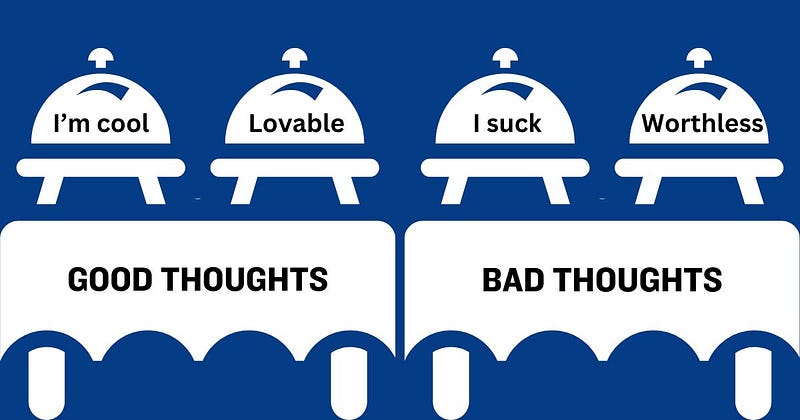A Fresh Perspective on Mental Health: Buffet of Thoughts
Written on
Understanding the Concept of a Buffet
For those unfamiliar with an all-you-can-eat buffet, here's a quick overview. You pay a fee ranging from $14.99 to $79.99, influenced by your location, whether in Koreatown, Los Angeles, or the Bellagio in Las Vegas. Once you’ve paid, it’s time to dive in!
You have access to a vast array of culinary delights all day long. The only rule is to remain on the premises. Feel free to indulge in dessert before your main course, enjoy breakfast alongside crab legs, and don’t hesitate to go back for seconds or thirds.
At these buffets, you don't stop when you're satisfied; you stop when the guilt sets in.
The Parallel of Overactive Thoughts
Now, consider our restless minds. Sadly, we don’t just stop at negative self-talk like "I'm so dumb" or "I'm worthless." Instead, that’s often where we begin. Since thinking comes at no cost, we engage in it relentlessly, every waking hour.
While practices like meditation can provide temporary relief, we inevitably carry our thoughts into the night. Before you react and say that thinking is a natural process, I agree. It’s an incredible ability that has driven human innovation. But what purpose does it serve if it only leads to negative feelings? Isn’t it time to reassess our thought patterns?
Loving Yourself Through Thought Choices
Feel free to think as much as you want, but remember to embrace self-love. For years, I’ve roamed the self-help sections of countless bookstores and libraries, reading extensively about grief and personal improvement. I became a certified clinical hypnotherapist and a Master NLP practitioner back in 2009, though I haven’t actively practiced. You might assume I have it all figured out when it comes to self-love.
"Love yourself" is a mantra we see everywhere—etched into sidewalks, tattooed on skin, and frequently quoted by therapists. Yet, many of us struggle to understand how to genuinely practice it.
You might think you know how to love yourself—perhaps indulging in bubble baths, enjoying drinks with friends, or even treating yourself to a spa day. But is that truly self-love? Until recently, I didn’t grasp what it really meant. After watching a brief clip of Louise L. Hay, the essence finally clicked for me: loving yourself means to stop frightening yourself.
The Cycle of Fearful Thoughts
How often do we select thoughts that terrify us, yet we persist in doing so? It's not our fault; our nervous systems and subconscious minds are wired to cling to the familiar because it feels safe. If our only experiences are negative, our minds will subconsciously recreate those circumstances to maintain that safety.
It's easier to default to unhelpful thoughts because they are readily available—just like grabbing another slice of cake at a buffet. Why do beneficial or positive thoughts feel harder to embrace? It’s often because we struggle to believe them. If you’re not used to affirming your achievements, the idea that you did well can feel immensely uncomfortable.
The New Standard: Embracing Discomfort
Embracing discomfort is the new norm. Each uncomfortable yet constructive thought you introduce into your mind can pave the way toward a more fulfilling life.
Returning to the buffet analogy, while salads and legumes might not be as appetizing as desserts, their long-term benefits are undeniable. The more you incorporate them into your diet, the easier it becomes to enjoy them.
Ultimately, the choice is yours. You can remain a discontented adult, or you can recognize that nurturing yourself is akin to caring for a child. Would you feed that child junk food all day? More importantly, would you want to instill fear in them?
This isn't about enforcing toxic positivity or ignoring genuine feelings of sadness and trauma. It's about acknowledging that you have a choice. You don’t have to dwell in negativity constantly.
The Importance of Awareness
Awareness and effort are vital. It’s hard work, but if you're tired of feeling down, you’re the only one capable of changing your mindset.
Recognize when negative emotions arise and consciously choose more uplifting thoughts. It doesn’t have to be a monumental leap; even a slight shift in perspective can help. Once you venture to the brighter side, it becomes more manageable. If you struggle, try to replace the negative thought entirely.
Consider what excites you or brings you joy. Louise Hay used to focus on yellow roses when her thoughts wandered into darkness. It could be anything—blue butterflies, your pet’s eyes—just shift away from scaring yourself.
Self-Love in Everyday Life
Remember, what you cherish, you won't want to frighten. And yes, you can still treat yourself to a new set of bath bombs.
Thank you for reading! If you’d like to be notified when I publish new content, please subscribe. You can also support my writing by buying me a coffee or leaving a tip—any help is greatly appreciated!
Chapter 1: The Buffet of Thoughts

Section 1.1: Exploring Self-Love
The first video offers a fascinating tour of an all-you-can-eat buffet in Los Angeles, showcasing the variety and abundance available.
Section 1.2: Understanding Global Buffets
This second video highlights the top five best all-you-can-eat buffets around the world, revealing the culinary experiences that await.